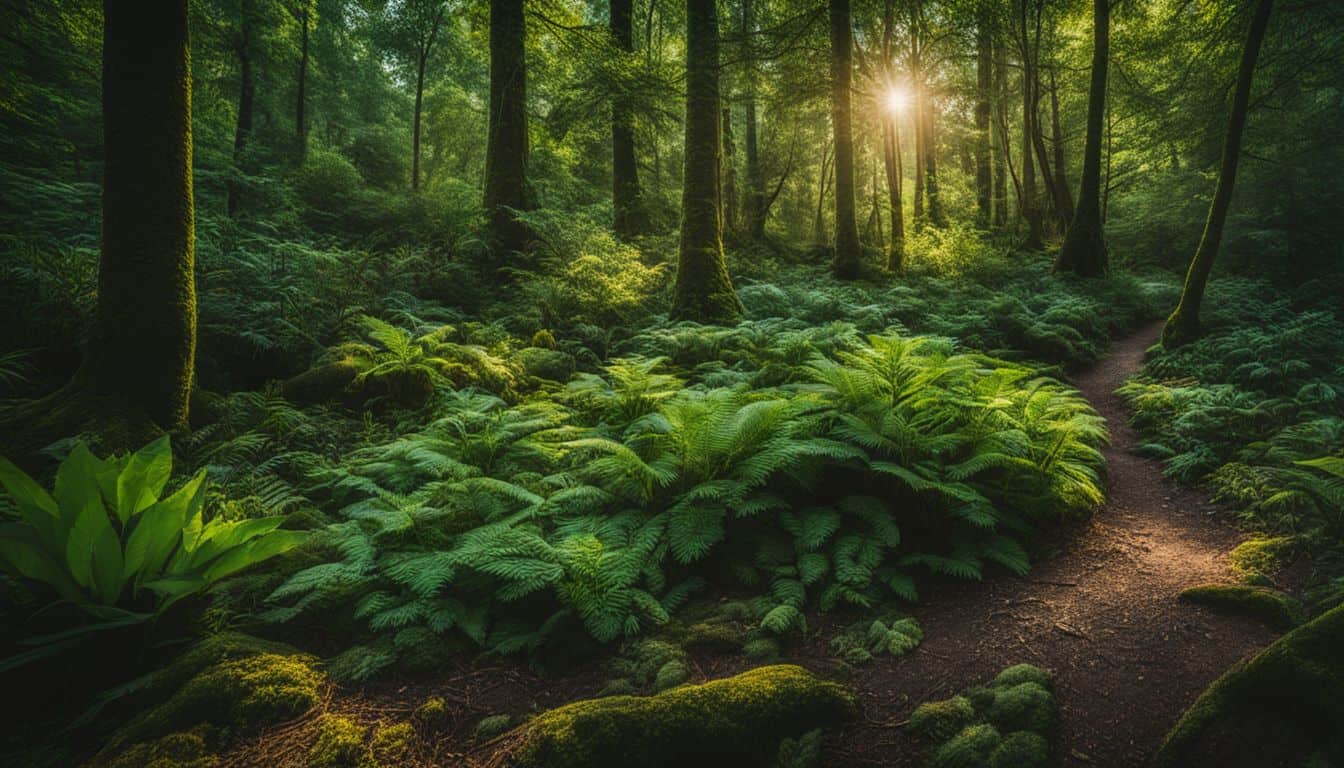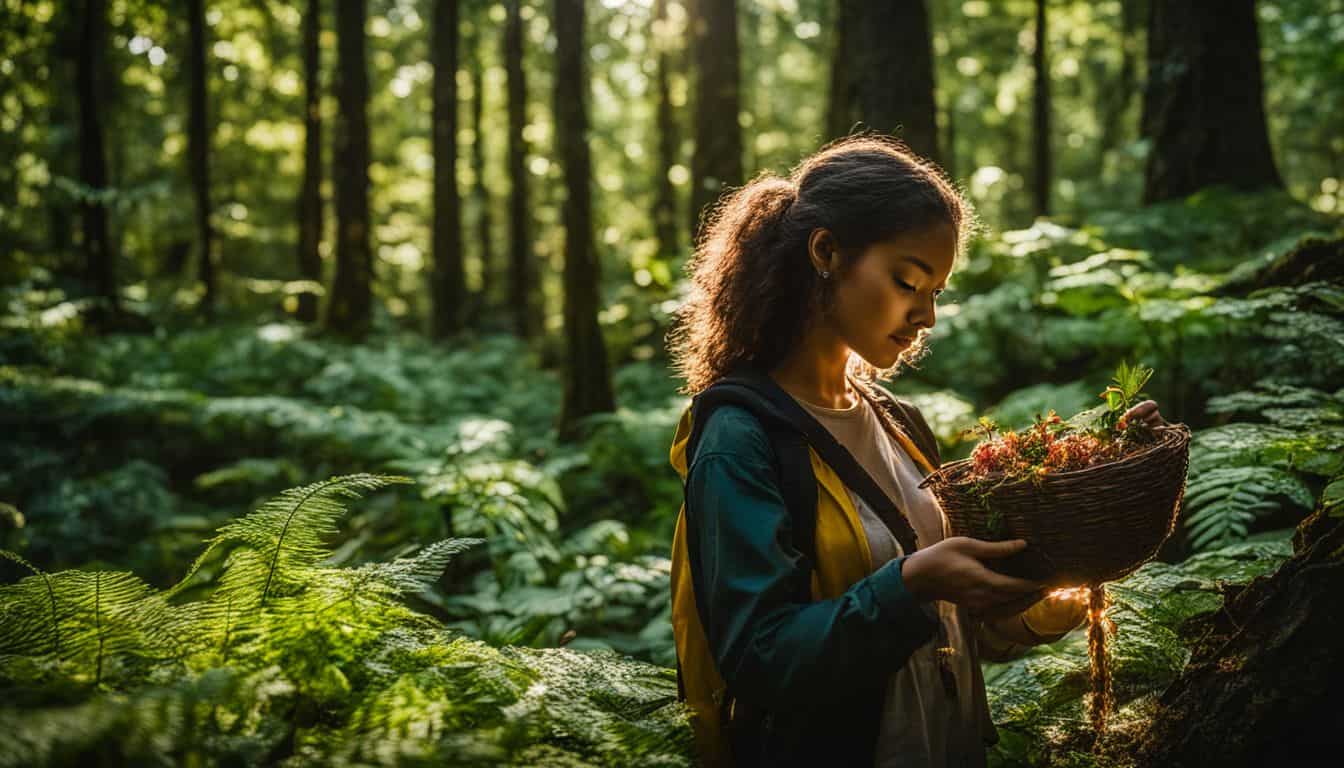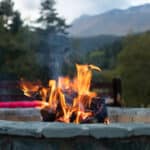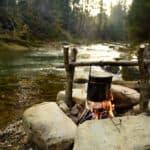Venturing into nature’s pantry can be an alluring adventure, yet the risk of mistaking poisonous plants for edible ones is a genuine concern. Foraging is not just a pastime; it’s an ancient survival skill that connects us to our environment and can enrich our diet with natural, wholesome foods.
Our guide will arm you with crucial knowledge about which wild plants and fungi are safe to eat and how to harvest them responsibly. Dive in for a safe foraging journey!
Table of Contents
Key Takeaways
- Before harvesting wild plants or fungi, confirm their identities with reliable field guides or identification apps such as iNaturalist to avoid poisonous look-alikes.
- Always forage responsibly by adhering to local laws, never overharvesting, and avoiding areas that may be contaminated or protected to ensure sustainability and safety.
- Certain wild edibles like nasturtiums, prickly pear cacti, morel mushrooms, pine nuts, chickweed, dandelions, rose hips, blackberries, Chicken of the Woods mushrooms, and amaranth can enrich your diet both nutritionally and with new flavors when correctly identified and harvested.
- Deadly plants and fungi like the Death Cap mushroom Amanita phalloides, Monkshood Horse nettle, Doll’s eyes, Hemlock, Oleander, poison ivy, and Lantana should always be avoided. Their consumption can lead to severe health consequences or even death.
- Wear appropriate clothing, such as gloves and long sleeves, when foraging for plants like blackberries to protect against thorns; carry a basket or container for collecting your finds without damaging them.
Tips for Safe Foraging

Venturing into the realm of wild edibles can be a delightful journey, but safety must always come first. Learn to navigate this green space responsibly, emphasizing accurate plant identification and sustainable harvesting techniques that protect both you and the environment.
Understanding the basic rules of foraging
Learning the fundamental rules of foraging sets you on the right path to gathering wild foods safely. Before picking any plant or mushroom, be certain of its identity; mistaken identification can have dangerous consequences.
Use reliable field guides or plant identification apps such as iNaturalist to verify what you find.
Respect nature’s balance by considering how taking plants might affect their growth and sustainability in the area. Follow ethical foraging practices, including never overharvesting and avoiding areas contaminated with herbicides or heavy metals.
Ensure your foraged finds are from places where it is legal to harvest, and remember that responsible practices help preserve wilderness areas for future generations.
Proper plant identification
Having a firm grasp on the basic rules of foraging sets the stage for the critical skill of plant identification. Knowing how to identify plants correctly can protect you from harmful toxins, as some edible species closely resemble poisonous ones.
Mastery in this area involves studying characteristics such as leaf shape, color, texture, and even habitat because mistaking an edible herb for its toxic look-alike could have serious health consequences.
Seek guidance from field guides or smartphone apps designed to assist with botanical differentiation before putting anything on your plate.
Accurately identifying flora doesn’t just prevent illness; it fosters respect and appreciation for nature’s diversity. Engage with local experts like botanists and herbalists who offer workshops where hands-on experience can bolster your recognition skills.
These professionals can provide insights into telltale signs that differentiate safe-to-eat wild carrots from dangerous hemlock roots or help you distinguish nutrient-rich amaranth seeds from less beneficial weedy imposters.
Being informed is empowering—it transforms simple walks through nature into opportunities to safely harvest diverse and nutritious wild foods that enhance your culinary adventures without risk.
Responsible and legal foraging practices
Foraging the right way means thinking ahead and respecting nature’s balance. Knowing your local laws about wild harvesting is crucial, as some plants may be protected or their collection regulated to prevent overharvesting.
Stick to picking in allowed areas and avoid trespassing on private property or protected conservation lands. Look for signs that the area might not be safe due to herbicide contamination or heavy metal pollution.
Leave no trace behind while you collect wild edibles like dandelion roots, morel mushrooms, and rose hips; use tools that minimize harm to plant life. Take only what you will use, leaving enough behind so plants can regrow and sustain their populations – this is an essential part of foraging ethics.
Be mindful of invasive species like garlic mustard; removing them can actually benefit local ecosystems. Always make sure your activities promote a sustainable lifestyle and support the health of forests where future generations can also enjoy the bounty of nature.
Popular Edible Plants and Fungi

Discover a world of natural flavors waiting right in your backyard or along that forest trail! Exploring the richness of edible wild plants and fungi, such as succulent Nasturtiums and savory Morels, can transform your culinary adventures with tastes you won’t find at the grocery store.
Nasturtium
Nasturtium, a vibrant addition to any forager’s basket, offers more than just its eye-catching blooms. Every part of this plant is edible; the leaves, flowers, and seeds spice up a salad with their peppery flavor akin to watercress or arugula.
Thriving in gardens and along fences across many parts of the country, this plant is easy to spot with its round leaves and bright orange, yellow, or red flowers.
Foragers love nasturtium not only for its taste but also for its health benefits. Packed with nutrition, including vitamin C and various minerals, it can boost your immune system naturally.
Its versatility extends beyond fresh eating: capers can be mimicked by pickling the green seeds! Moving on from these punchy plants—the prickly pear cactus awaits with its unique fruit and paddles that turn wilderness into an impromptu feast.
Prickly pear cactus
The Prickly Pear cactus thrives in the dry, sunny climate of the American southwest and Mexico, offering adventurers a taste of the wild. Its fruits and pads are edible but require careful preparation: you must strip away their intimidating spines before enjoying their offerings.
Venture into this foraging experience with respect for its natural defenses, and you’ll find a delicious reward waiting.
Unlock flavors from the arid landscape by transforming Prickly Pear cactus fruit into a vibrant pink juice known for its refreshing taste. This desert gem provides more than just hydration; it connects foragers to traditions spanning centuries where humans have relied on these hardy plants for nourishment.
Approach harvesting sustainably to enjoy a burst of flavor and an authentic connection to our ecosystem’s resilience and bounty.
Morel
Morel mushrooms are sought after by many fungus enthusiasts and gourmet cooks alike. They stand out with their distinctive honeycomb appearance, which is a stark contrast to the smooth caps of other common edible fungi.
Before setting out on your mushroom hunting adventure, check local regulations as morel foraging can be subject to specific guidelines in some regions.
Finding these prized fungi requires a keen eye; they often blend into their woodland environments. Look for them in springtime when the soil is moist and warm, often under deciduous trees like elms and ashes or in areas recently burned by forest fires.
Harvest morels sustainably by cutting them at the stem rather than pulling them out of the ground, ensuring continued growth for seasons to come. Enjoy incorporating morels into your dishes, but always handle them with care – confirm identification with certainty because misidentified mushrooms can be dangerous.
Pine nuts
Moving from the earthy delights of morels, let’s turn our attention upwards to the branches where pine nuts hide. These little gems nestle inside the tough exterior of pinecones, and harvesting them can be quite an adventure.
Pine nuts are not just a tasty snack; they’re also packed with nutrients, making them popular among nutritionists and chefs.
Pine nuts require patience as you crack open each cone, but your efforts will be rewarded with ingredients perfect for pesto or a crunchy salad topping. However, it’s important to note that these nuts should not be counted on as a primary food source in a survival situation due to their limited availability and the time-intensive process required to collect them.
Foragers prize pine nuts for their unique flavor and versatility in recipes, transforming ordinary dishes into culinary masterpieces with just a sprinkle.
Chickweed
Chickweed, known scientifically as Stellaria media, is a delightful addition to the forager’s basket. This small plant boasts little white star-shaped flowers and thrives in cool, moist areas.
Not only does it carpet forest floors across various regions, but chickweed often pops up in urban settings, too. Foragers prize chickweed for its mild flavor, which resembles spinach and is perfect fresh in salads or cooked as a nutritious green.
Harvesting chickweed brings more than just taste to your table; it’s also packed with vitamins and minerals valuable for your health. Seek out patches away from contaminated areas to ensure you’re getting the best nature offers without the risk of heavy metal contamination or residual insecticides.
Before moving on to discover plants like dandelion or rose hips, be sure you can clearly identify chickweed’s smooth oval leaves and tender stems to enjoy this wild edible treasure safely.
Dandelion
Dandelions aren’t just pesky lawn weeds; they’re a treasure trove of nutrition and have been used in kitchens and medicine cabinets for centuries. With their unmistakable bright yellow flowers, dandelions (Taraxacum officinale) are often one of the first plants budding foragers learn to identify.
The beauty of this plant is that every part is edible—the leaves add a punchy flavor to salads or can be sautéed as a healthy green, while the petals offer a colorful boost to jelly or wine.
For those seeking an alternative to morning coffee, roasting and grinding dandelion roots creates a surprisingly delightful substitute. This versatile plant spruces your meals and delivers medicinal uses long appreciated in herbal traditions.
It’s easy to see why dandelions have moved from being an invasive weed on lawns across America to becoming a staple in wild foraging adventures and inventive culinary creations.
Rose hips
Moving from the humble dandelion, the rose hip is another forage-friendly plant to consider. These small, vibrant fruits burst forth from rose bushes and offer a treasure trove of vitamin C.
The bright orange or red hues signal their ripeness, and they can be plucked right off the bush for a quick, nutritious snack. Rose hips don’t just stop at being a tasty treat; these hardy little fruits are versatile in the kitchen.
Crafting homemade delights with rose hips is both rewarding and healthful. Transform them into a sweet jelly that pairs perfectly with morning toast, or blend them into sauces that add zing to your dishes.
For those chilly evenings, steeping rose hips in boiling water creates an aromatic tea that’s soothing and packed with antioxidants. Whether you’re out collecting these gems for immediate consumption or thinking about preserving their flavors for later use, rose hips stand out as a valuable addition to any natural pantry.
Blackberries
Blackberries, those juicy aggregate fruits we all love, are packed with vitamins and offer a tasty reward for your foraging efforts. Thriving in the wild, these bramble berries can be found along sunny forest edges and are ripe for picking in late summer.
Be sure to wear gloves and long sleeves when harvesting blackberries; their sharp thorns can catch you by surprise.
Before placing these delicious berries into your basket, look closely at their color – deep purple-black is perfect for picking. These fruits do more than just make a delightful snack or dessert ingredient; they’re also high in nutrients that support overall health.
Enjoy blackberries fresh off the vine, turn them into jams, or bake them into pies to savor the sweet taste of nature’s bounty.
Chicken of the Woods
Chicken of the Woods isn’t your typical mushroom. This vibrant fungi stands out with its bright orange to yellow colors and delights foragers with its soft, succulent texture. Found adorning the trunks of trees in eastern North America and across Europe and Australia, this edible gem graces many a basket during mushroom hunting expeditions.
What sets Chicken of the Woods apart is its look and its versatility in the kitchen. Due to its hearty consistency, it is often used as a meat substitute, bringing a mild, lemony flavor that can transform vegetarian dishes into savory delights.
Whether sautéed or simmered, these mushrooms offer a delightful twist for culinary adventurers eager to explore the tastes of wild fungi.
Amaranth
Amaranth stands out as a nutritious wild edible that is often overlooked. This plant sports broad leaves and vibrant red, gold, or purple flowers that are not just pretty to look at—they’re completely edible too.
Amaranth thrives in various environments, making it accessible for foragers across different regions. It’s packed with protein, vitamins, and minerals which makes it an excellent addition to your diet.
Use the leaves of amaranth in salads or steam them like spinach for a healthy side dish. The seeds are another superfood from this versatile plant; they can be cooked similarly to quinoa or ground into flour.
Harvesting amaranth requires discerning eyes as it resembles some non-edible plants—always double-check your identification before adding it to your basket! Enjoy the bounty nature offers, but do so by harvesting responsibly to ensure sustainability and legal compliance with local regulations.
Dangerous Plants and Fungi to Avoid
Venturing into the wild to forage carries an inherent risk when it comes to plants and fungi, as some are not just inedible but can be fatally toxic. It’s crucial to differentiate between nature’s bounty and its dangers; our survival may depend on recognizing what must never find its way to our baskets.
Death Cap mushroom
The Death Cap mushroom, known scientifically as Amanita phalloides, is an unassuming yet deadly fungus. It is responsible for the majority of fatal mushroom poisonings worldwide. Despite its lethal nature, it resembles several edible species, which makes accurate identification crucial for mushroom hunters.
This dangerous mushroom has found its way into various regions across the globe and poses a serious risk to those who mistake it for harmless varieties. It’s essential to have extensive knowledge about this invasive species before considering plucking any mushrooms from the wild.
Confusing a Death Cap with an edible lookalike could lead to grave consequences. Always seek expert advice or thorough guidance from reliable sources if you’re unsure about the safety of any fungi you encounter in nature.
Monkshood
Continuing our journey through the garden of hazardous flora, let’s focus on Monkshood. Known for its vibrant helmet-shaped flowers, Monkshood is a plant that commands attention. However, beneath its striking beauty lies a dark secret: it carries the potent toxin aconite, earning it the notorious title ‘Queen of Poisons’.
This dangerous substance can have fatal consequences if ingested or even handled improperly.
Found primarily in mountain meadows across the Northern Hemisphere, Monkshood should be treated with extreme caution. Its lethal reputation is well-earned and serves as an urgent reminder to foragers to prioritize safety above all when exploring wild plants.
Stick to admiring this medieval poison from afar and ensure your outdoor adventures remain safe by keeping clear of any temptation to pick or use this deceptive bloom.
Horse nettle
Horse nettle can easily trick an unwary forager with its fruit that looks like tempting yellow cherry tomatoes. However, this plant is native to the American South and packs a dangerous poison.
It’s important to master the skill of identifying horse nettle so you don’t mistake it for edible plants. You’ll often find it growing among other vegetation where invasive weeds creep into your garden or pastureland.
Although horse nettle may share similarities with harmless vegetables in appearance, eating any part of this plant can lead to serious health risks. Its deceptive nature serves as a vital reminder of why correct identification is essential before consuming any wild plants.
To ensure safety in your foraging adventures, put learning about poisonous species at the top of your list—your well-being depends on it. Next up: another plant that needs careful avoidance – Doll’s eyes also demand attention due to their toxicity.
Doll’s eyes
Doll’s eyes, also known as White Baneberry, display striking white berries with a dark dot that eerily resemble the eyes of a porcelain doll. These ominous little fruits might catch your eye while exploring forests in the eastern United States, but don’t let their unique appearance tempt you.
Every part of this plant is packed with dangerous toxins that can be lethal if ingested. Experienced foragers know to steer clear of these deceptive berries, which carry potentially grave consequences.
Handling Doll’s eyes should also be done with extreme caution, as even skin contact has been reported to cause discomfort. The telltale sign of its toxicity lies in its seductive look – nature’s way of saying, ‘Do not touch.’ Venturing through forestry filled with diverse flora like Doll’s eyes demands respect for nature and knowledge about what lies beneath the leaves and stems we encounter.
Remember, looks can be deceiving when it comes to wild plants, and Doll’s eyes are a perfect example of hidden dangers in beautiful guises.
Hemlock
Hemlock lurks as a silent threat in the underbrush, its feathery leaves waving innocently by streams and along roadsides. This plant’s sinister nature is masked by its resemblance to harmless herbs like wild carrots or parsnips.
Foragers must heed the danger Hemlock poses; it’s a mistake with potentially lethal repercussions. Its toxins can wreak havoc on the nervous system, resulting in severe symptoms or even death if ingested.
Identifying this toxic plant requires skillful knowledge of its purple-spotted stems and unpleasant odor when crushed. It’s not native to American soil yet spreads widely across various states, deceiving eager foragers who may be drawn to what looks like an edible find.
Exercise extreme caution near Hemlock – your health may depend on it!
Oleander
Moving from the dangers of Hemlock to another toxic plant, Oleander stands out as a particourularly hazardous shrub. It’s crucial for foragers to recognize that every part of this common decorative plant is laced with toxins.
Even breathing in the smoke from burning oleander can cause severe health issues.
Oleander may display enticing clusters of flowers ranging in color from white to deep pink, but make no mistake: this plant is not your friend in the wild. Eating just a small amount can lead to dire consequences.
Training yourself to spot its long, slender leaves and vibrant blossoms could be vital during your foraging expeditions, ensuring you steer clear for safety’s sake.
Poison ivy
Shifting our focus from one dangerous plant to another, poison ivy is a significant threat in the wilderness. Recognized by its notorious “leaves of three,” this plant can cause severe itching and rashes upon contact with skin.
Foragers must learn how to identify it quickly because accidentally brushing against it or mistakenly adding it to your collection can lead to an uncomfortable experience.
Poison ivy contains urushiol oil, which is responsible for the allergic reaction that many people endure.
This devious greenery is not only unwelcome due to its irritating effects but also because its appearance varies greatly by region and season, making identification challenging even for experienced outdoors enthusiasts.
Leaves may appear shiny or dull, and they change colors with the seasons – remaining vigilant is always essential. Foragers are advised never to touch plants unless they are absolutely certain about their safety; assume that any unfamiliar plant might be poison ivy and steer clear.
And remember: clothing that comes into contact with poison ivy can also harbor urushiol oil, so handle gear carefully after an outdoor adventure!
Lantana
Moving on from the familiar itch of poison ivy, we encounter lantana, a plant with vibrant flowers that can deceive unsuspecting foragers. Although lantana brightens up gardens and wild areas with its colorful blooms, it harbors a dangerous secret: toxins that are detrimental to the liver.
Found primarily in the American tropics, this poisonous plant demands respect and distance. Its allure is best appreciated from afar because ingesting any part of it can lead to serious health problems.
Don’t let its beauty fool you; properly identifying plants like lantana is crucial for safe foraging. It’s one thing to admire their vivid clusters from behind your camera’s lens or share images across social media platforms – quite another to mistakenly add them to your basket during a gathering expedition.
Understanding which plants pose risks allows you to enjoy nature’s bounty without putting yourself in harm’s way; keeping clear of deceptive species such as lantana ensures your outdoor adventures remain both rewarding and secure.
American wisteria
Just as Lantana presents hidden perils, the American wisteria demands caution, too. This vine is often admired for its hanging clusters of aromatic flowers and its robust growth in the wild landscapes of the eastern United States.
However, beauty can be deceiving; while wisteria flowers add a touch of purple splendor to any setting, their seeds harbor a dangerous toxin known as glycoside. If ingested, these seemingly innocuous seeds can trigger severe symptoms like stomach pain, vomiting, and diarrhea.
The inviting aroma of American wisteria’s blooms might entice the unsuspecting forager or an unwary admirer seeking to sample wild edibles. But it’s crucial to recognize that not all plants that offer visual and olfactory delight are meant for consumption.
The majestic draping vines may enhance your garden aesthetics or inbox with floral photos—just remember they’re best appreciated from afar! Never let curiosity lead you to taste the pods or seeds; doing so could result in an urgent visit from unwanted side effects due to this plant’s toxic nature.
Manchineel
While American wisteria is often admired for its beautiful cascading flowers, it’s essential to pivot our attention to a far more dangerous plant. The Manchineel tree, sometimes called the “tree of death,” is one of nature’s most toxic offerings.
Located in warm climates such as southern Florida and Central America, this tree demands respect and caution.
Touching the sap alone from the Manchineel can lead to painful blistering; an encounter with its fruit, which may appear inviting, holds deadly consequences. Foragers must realize that not all trees bearing fruit are friends and should keep a safe distance from these deceptive dangers lurking among tropical beauty.
Conclusion
Venture into the wild with confidence and a keen eye for safety. With knowledge in hand, you can enjoy nature’s bounty without worry. Remember to respect the environment and always prioritize caution in your foraging adventures.
Happy hunting as you explore the flavors of the forest!
Are There Specific Safety Practices I Should Know When Foraging for Wild Plants and Fungi?
When embarking on the journey of foraging for wild plants and fungi, it’s crucial to educate yourself on safety practices. A beginner’s guide to foraging edible plants can provide valuable information on identifying poisonous species, proper harvesting techniques, and precautions to take while exploring the wilderness. Happy foraging!
FAQs
What should I know about foraging for wild plants and fungi?
When you’re out in nature, it’s crucial to identify edible plants like dewberries and mushrooms correctly. Make sure you avoid dangerous ones like A. Phalloides, which is a toxic mushroom.
How can I tell if wild fruits are safe to eat?
Learn to recognize safe-to-eat wild fruits such as persimmons (Diospyros virginiana) and bramble berries before harvesting them. Always double-check with reliable sources or local experts.
Are there any benefits to eating wild plants?
Yes! Many wild plants offer unique flavors and nutrition; some, like white sage or pinyon pines nuts, are considered medicinal by dietitians due to their health properties.
Can I use analytics tools when foraging for edibility?
While analytics tools aren’t directly used in picking wild foods, they help us understand trends in foraging interest by analyzing data like search queries and bounce rates on related topics online.
Is picking any plant or fungi from national forests legal?
Check the regulations of places like Allegheny National Forest before collecting; some areas may have restrictions or require permits for harvesting certain species.







Leave a Reply